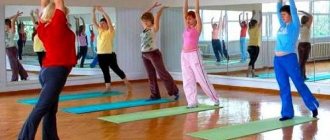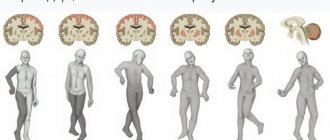VSD is a multifactorial structural and functional disease that has cardiovascular and neurogenic symptoms; characterized by asthenia, poor tolerance to physical activity and stress.
In the general structure of cardiovascular diseases in adults, it accounts for 12-35 percent. Patients are mainly women from 16 to 45 years old.
VSD and sport are compatible concepts, but the severity and course of the pathology should be taken into account.
The influence of VSD on exercise tolerance
Playing sports with VSD is permissible in almost all cases, but with some restrictions. The load should be chosen in consultation with the attending physician and depending on the state of health.
With a mild course, maintaining the ability to work, good tolerance to physical activity, and minimal pain, it is allowed to engage in almost all types of sports. The diagnosis of “vegetative-vascular dystonia” does not limit activity in any way.
Permitted types of loads:
- run;
- fitness;
- yoga;
- Pilates;
- a ride on the bicycle;
- step aerobics using a low platform;
- swimming;
- skating;
- fitball
The average severity of the pathology with some decrease in working capacity and periodic vegetative crises does not cancel sports activities. You should monitor your heart rate and if it increases, stop training and rest.
A severe degree with severe respiratory disorders, frequent vegetative-vascular crises, and pressure changes implies refusal to exercise in the gym. For such patients, the doctor must select a complex of exercise therapy.
An approximate set of exercises:
- describe circles with your hands in different directions;
- put your palms together in a locked position and press them against each other for fifteen seconds;
- tilting the head in different directions for five to six approaches;
- circular movements of the shoulders, slightly turning the torso to the right and left;
- hands on the belt, fix the leg bent at the knee for 4-5 seconds, do seven approaches for each limb.
If the load causes darkening in the eyes, increased heartbeat, chest pain, dizziness, severe weakness, you should stop immediately, drink water and a sedative. Further tactics should be discussed with your doctor.
How to plan a training regimen for a patient with VSD?
Classes begin with stretching, smooth movements, controlling breathing and heart rate.
First, the exercises are performed for 7-12 minutes. When training, you should avoid positions with your legs raised up. It is important to combine aerobic and anaerobic exercise to engage all muscle groups. There is no need to allow yourself to become exhausted; only a feeling of slight fatigue is possible . You should not exercise in a stuffy room; if you feel unwell, it is recommended to temporarily stop training.
Breathing requirements when playing sports:
- smooth inhalation through the nose and exhalation through the mouth;
- breathe with your diaphragm;
- The breathing rhythm must correspond to the movements performed.
Restrictions in sports activities for patients with dystonia: when and how to introduce them?
Vegetative-vascular dystonia and sports are incompatible professionally. Patients with any type of VSD should avoid super-intense exercise, since extensive symptoms limit the endurance and performance of the athlete.
You should not participate in professional team sports, especially playing for results at any cost. This could trigger a crisis.
Weightlifting or powerlifting is prohibited for dystonic patients. Any wrestling, boxing, or sparring in martial arts is prohibited. These sports involve sudden lunges without respite, which leads to increased blood pressure, shortness of breath, and dizziness.
The following types of load are contraindicated:
- barbell bench press;
- parachuting;
- acrobatics.
What is VSD?
Vegetative-vascular dystonia is a heart disease that can lead to unpleasant symptoms:
- tingling, heaviness in the chest,
- dyspnea,
- dizziness,
- pressure surges (hypertensive and hypotensive crises),
- headache,
- difficulty breathing,
- increased anxiety and fatigue.
With VSD, the autonomic nervous system begins to malfunction, and the body experiences a lack of oxygen and nutrients. Therefore, it is important to respond in a timely manner to the appearance of spasms in blood vessels and symptoms of the disease, and to take preventive measures so as not to start a pathological process that can lead to serious consequences.
The diagnosis is made by a specialist; self-medication is unacceptable. Only based on the results of the electrocardiogram, the doctor will develop a treatment method and physical exercises. The sport should contribute to positive dynamics and have a calming effect on the cardiovascular system and vestibular apparatus.
conclusions
Patients with VSD are advised to spend more time in the fresh air, strengthen their muscles by walking and running, and improve their diet. It is necessary to rationally build a work and rest schedule and eliminate stress.
Sports for VSD help reduce the active symptoms of the disease and reduce its severity.
The following sources of information were used to prepare the material.
Vegetative-vascular dystonia, which occurs in every third inhabitant of the planet, is psychological in nature and occurs due to neurosis, stress, hysteria and neurotic disorders. VSD is not an independent disease, but is a complex of symptoms that develops as a result of dysfunction of the autonomic system of the human body. Autonomic dysfunction does not pose a serious threat to human health, but it significantly complicates the patient’s life, causing a lot of discomfort.
Features of the development and treatment of VSD
The autonomic nervous system (ANS) is responsible for the functioning of systems and organs in the human body. When its functioning is disrupted for some reason, it negatively affects the functioning of other parts of the body. The vegetative system consists of two sections that are interconnected.
One of them is responsible for relaxing the body, and the other is responsible for tension. And if a failure occurs in one of these departments, then the body will be either in a relaxed or tense state, which is wrong in both cases. The reasons for the development of autonomic dysfunction can be varied, but the problem is psychological in nature. Although pathology can arise from diseases.
A malfunction in the functioning of the VNS manifests itself as follows:
- sudden surges in pressure;
- headaches, dizziness;
- fainting, weakness, irritability;
- pain in the heart area;
- breathing problems: shortness of breath, suffocation;
- nausea and vomiting;
- sleep disturbance;
- hot flashes, chills;
- frequent urination, increased sweating;
- panic attacks, fear, anxiety.
If you have symptoms, you should consult a doctor who, after diagnosis, will diagnose vegetative-vascular dystonia and prescribe comprehensive treatment. The main stage of VSD therapy is communication with a psychotherapist. It will help normalize the psycho-emotional state and relieve the patient of panic and fear. The initial stages of therapy are not complete without drug therapy and non-drug treatment, some of which include sports activities.
What to choose?
Before starting training, it is important to carefully ensure that the chosen sport is suitable for the patient. Vascular dystonia prohibits strength training, in addition, the person often suffers from shortness of breath. It is important that the chosen sport does not aggravate the situation, but rather has a beneficial effect on it.
Fitness at home
This option has its advantages and disadvantages. The advantages include:
- a person can regulate the load himself;
- classes are held at a convenient time;
- a person does not suffer from the opinions of others;
- financial inclusion.
Among the disadvantages is the lack of a program and control over the number of approaches. A person can give too much load, which will lead to a worsening of the condition, or, conversely, too little load will not produce results. More often than not, when doing things on your own, a person does not achieve what he wants. People suffering from this disease often cannot cope with their own laziness, as well as organize their leisure time.
Running and other cardio exercises
Physical activity has a beneficial effect on the heart and restores the nervous system.
Running during VSD is very useful. While running, a person uses almost all muscles. To supply all muscles with oxygen, the heart begins to work actively. If you run correctly and gradually increase the load, then cardio exercise can save a person from all manifestations of VSD. Running can save a person from neuroses, depression and other nervous system disorders.
It is often a consequence of panic conditions, stress and neurotic disorders. Many people have already encountered similar manifestations. This is not a disease, but a complex of symptoms resulting from disturbances in the autonomic function of the body. The scientific name for this is symptom complex. But is sports possible with VSD?
Exercising your body is really beneficial, but only with the right approach can you avoid harming your body even more. Due to incorrect actions, overload of the autonomic system can provoke complications in the functioning of any system of the body or disturbances in the functioning of internal organs. What to do when diagnosed with VSD and how to properly distribute the load to maintain body and spirit in harmony?
The autonomic system is part of the central nervous system and is responsible for the functionality of all internal organs and their interaction within the system. She is responsible for the following functions:
- ensuring the interaction of reflexes and brain signals;
- perception of the environment, relaxation or tension depending on the factors affecting the psyche;
- the first solution is to activate the parasympathetic department of the autonomic nervous system: nutrition, rest, sleep;
- the second is the sympathetic department: defense and attack of the body.
The ANS consists of two departments, each of which is responsible for its own functions. One allows the body to relax, the other allows the body to tense up.
Recommendations regarding sports for VSD
Moderate exercise is recommended for people, especially those who suffer from VSD. Although doctors considered sports contraindicated for dystonia, physical activity has been proven to help cope with panic attacks. Regular physical exercise trains the cardiovascular system, improves the condition of blood vessels, and also sets the body up for positivity and makes it stress-resistant. But in order for the result to be effective and bring a positive result, it is necessary to find a suitable sport and adhere to medical recommendations:
- Do not overload the body with physical exercise. Classes should be satisfying;
- the load will be gradual, and the intensity of the exercises will increase;
- active exercises to keep a person moving;
- exercise outdoors. If this is not possible, then the room in which classes are held must be ventilated;
- sportswear and shoes should be comfortable and not restrict movement;
- the exercises will not be monotonous and monotonous;
- if you are going to measure your blood pressure and pulse, then do not do it after training, but let your body rest and calm down;
- use all muscles;
- the load on the body will be prolonged and increasing;
- classes must be held regularly;
- playing sports should bring positive emotions and a feeling of relaxation, but not overwork. Don't force yourself to study if you don't want to do it. Play a song and dance to it.
If you adhere to these rules and choose a sport that you like, then your health will soon improve and changes will come. VSD and sport are compatible with each other, but with the right approach.
The main advantages of running with VSD Running with VSD in the morning
The main advantages of running during VSD are not only the normalization of blood pressure, but also the stabilization of health in general;
this is getting rid of VSD; this is self-affirmation and a kind of victory over oneself. How nice it is that, although you have grown older in years, you have not aged physically. You are not registered with the notorious dispensary, you do not visit a doctor and you lead a completely natural life, without bothering your household and work colleagues with your complaints. Running during VSD is a pulsating vital energy that makes all organs and systems of the body work harmoniously.
Running normalizes metabolism, makes blood vessels elastic, and therefore blood pressure is always good. It harmonizes the functioning of the gastrointestinal tract and genitourinary system, and therefore those who run are always in perfect shape, young not only in body, but also in soul.
Let's treat VSD by running! To start fighting a disease with the help of running, you need to decide what this running is for and whether you will do it seriously. After all, a lot of books and articles have been written about running, but still there are only a few people who run, and even fewer who run correctly, according to a certain method.
Some people run without even knowing where and how to count their pulse, while others, literally after a week or two of training, are trying to run a very long distance, and run quickly, not at their natural pace.
Others, due to bad weather, sit out in a warm apartment and only go for a run when the sun appears in the sky. The result is “breakdowns,” dissatisfaction, and even worse – exacerbation of existing diseases, or acute heart failure may occur.
Therefore, before you start running, you need to clearly define your own capabilities. It won't do any good if you run incorrectly. In particular, this applies to people prone to high blood pressure.
To begin with, it still makes sense to learn a little about self-control, at least about its elementary tests. We also need to understand the indications for running. It’s also a good idea to determine your psychological state.
For example, if a person has been suffering from many diseases for many years, he is impressionable and can react painfully to the mocking remarks of random ill-mannered passers-by, he should start running in special conditions.
Running during VSD in the morning
- When you run in the morning, you have to get up much earlier, often reducing your sleep time.
- Morning running takes place in cleaner air - fewer cars and, naturally, exhaust fumes.
- When jogging in the morning, there are much fewer passers-by, which means there is less chance of hearing offensive words addressed to you.
- In the summer, when running in the morning, the air does not yet breathe heat, and therefore for many it is much easier to run.
- In winter, when running in the morning, you often have to run in difficult conditions - the roads are not cleared or are cleared extremely poorly. In the morning there is always more frost, and therefore you really have to train in tougher conditions.
- After a morning workout, you feel just great all day long - the tonic effect of running continues to work.
Personally, I ran in the morning for many years and did not regret it at all.
Although I also noted the following point: no matter how hard I tried, my running speed in the morning was always much lower than in the evening or during the day.
What's the best way to start running in the morning?
- First of all, you need your own constant distance, which you will run in the morning. The increase in the running distance should be gradual and not abrupt. It is not advisable to experiment with speed. In a word, the loads must be constant.
- The best time to start running in the morning is summer; the body adapts to the load more easily in light clothing. In summer, it is most convenient to run in the mornings, because... The daylight hours are sufficient and it dawns early. You can start the day by dousing yourself with warm water, which helps you wake up and tone your body, and then you can gradually lower the temperature of the water - a kind of hardening procedure, and then run.
- If the nasopharynx is your weak point, then it makes sense to use nasal breathing while working, and in moments of acceleration, exhale through the mouth, pressing the tongue against the hard palate.
- After the onset of the cold season, you should dress warmer. For dousing, use warm water followed by rubbing, which helps to give a good body massage. Dry yourself with a woolen cloth. You should drink a glass of hot tea and wear warm clothes. Although over time, these conditions, due to increased resistance to cold, may not always be met.
- Monitor your heart rate and blood pressure after your run. The heart rate should increase by no more than 10-12 compared to the resting state. Blood pressure should decrease or return completely to normal. If this does not happen, you should look for the reason for this in too much distance, running speed or overwork or lack of sleep (in the case of a sleepless night).
1 visitor is viewing this page. Users: 1 robot
Source: https://xn——6kcpfdaaudd7a2a6d7d.xn--p1ai/utrennii-beg-pri-vsd/
Features of physical education for VSD
Only the right approach to sports with autonomic dysfunction will bring the desired result. Sport should gradually enter the patient’s life, with the right pace and intensity. If physical activity during VSD is great, then serious harm can be caused to the body. If a person’s level of training does not correspond to the level of physical activity, then pressure surges, tremors of the limbs and an increase in heart rate will occur, which will lead to an increase in the symptoms of the pathology.
With the right approach, a person will enjoy the activity, and after it feel relaxed and balanced. It is recommended to follow the principles of playing sports with VSD:
- the load should be local, aimed at one group of joints;
- avoid sudden movements, otherwise there is a risk of a strong decrease in pressure, loss of balance and injury;
- the head should not fall below the pelvis;
- you need to breathe constantly and fully;
- you need to alternate heavy loads with light aerobics;
- There should be a short rest between exercises.
Exercising on exercise machines or with sports equipment is acceptable for VSD, but in some cases it will be contraindicated. You should not take up a new sport without the permission of your doctor.
With VSD, you can play sports, but only with the right approach and in compliance with medical recommendations.
Sports against the backdrop of VSD
VSD refers to pathological signs associated with impaired functioning of autonomic reactions. Their list can be very extensive. We list the most common ones found in the clinic:
- headache;
- fluctuations in blood pressure and temperature;
- emotional lability;
- excessive sweating (hyperhidrosis);
- periodic and reversible sensitivity disorders (paresthesia);
- chilliness, or periodic feeling of heat;
- redness or paleness of the skin;
- panic attacks, or “vegetative storms”, which are accompanied by the fear of death.
Sport with such symptoms is a controversial issue.
- Some doctors try to convince patients that physical activity is undesirable for them and can aggravate the condition.
- But there are exercises to normalize the functioning of blood vessels. Therefore, VSD and sport are often interconnected. And in the end, life is movement. And for functional disorders, it is quite possible to choose the right exercises that will not cause unpleasant symptoms.
Sports for dystonia
The main advantages of running are not only the normalization of blood pressure, but also the stabilization of health in general; this is getting rid of VSD; this is self-affirmation and a kind of victory over oneself. How nice it is that, although you have grown older in years, you have not aged physically. You are not registered with the notorious dispensary, you do not visit a doctor and you lead a completely natural life, without bothering your household and work colleagues with your complaints. Running is a pulsating vital energy that makes all organs and systems of the body work harmoniously. Running normalizes metabolism, makes blood vessels elastic, and therefore blood pressure is always good. Running harmonizes the functioning of the gastrointestinal tract and genitourinary system, and therefore people who run are always in perfect shape, young not only in body, but also in soul.
Register Login.
Surprisingly, our website still doesn’t have a good article about one of the most popular tips for dealing with VSD—running.
But it is probably the most common activity among VSD athletes after autogenic training. Let's briefly and usefully review important points about running. So, running with VSD. At the beginning, let me remind you that I have already written about the psychology of sports. In that article, I explained exactly how sport affects the psychological state of a VSD person and how it [sport] changes us and our illness. Therefore, I will not repeat myself and will immediately move on to the main topic of the article. VIDEO ON THE TOPIC: VSD, Panic attacks and sports - Pavel Fedorenko
Basic recommendations
Sport is an auxiliary method of treating VSD, which increases the effectiveness of therapy. Before selecting a set of exercises, remember these simple recommendations:
- Physical activity should increase motor activity, but not cause sudden changes in body position.
- Don't train as hard as you can. Overload is fraught with deterioration in health.
- Constant monitoring of pulse and blood pressure after another workout causes unnecessary anxiety, which leads to an exacerbation of symptoms.
- Exercise in comfortable clothes and preferably in the fresh air.
- Combine different types of loads to activate all muscle groups.
Sports activities accompanied by your favorite music increase the productivity of your workout and improve your well-being.
In case of vegetative-vascular dystonia, vigorous sports are not recommended. Constant competition, anxiety and fear of losing provoke an exacerbation of the disease.
It is better to limit yourself to simple physical education. In this case, it will be possible to normalize the state of the cardiovascular and other systems while maintaining good health.
Benefits of physical activity
A set of physical exercises in the form of exercises and psychological ones in the form of faith in recovery will help strengthen the body comprehensively, weaken the memory of the disease, and improve the energy of thought.
You should not wait for lightning-fast results - immediately tune in to long-term work, this way you can defeat the disease and strengthen your defense against pathologies.
Those who rush things will have to deal with overtraining syndrome, when excessive physical activity causes an exacerbation of the disease. There is no need to give up exercise - immobility will not help cope with panic attacks and dystonia.
It is necessary to select an adequate amount of load so that the body can cope with it and not experience negativity. Stress is harmful, the pleasant sensations from exercise are beneficial. Everything that is done with pleasure fights dystonia.
In addition to physical activity, auto-training, meditation, relaxation exercises, relaxation, and aromatherapy will help. Thanks to normalized physical activity, the cardiovascular system is strengthened, bones and muscles become stronger, the respiratory organs begin to work smoothly, and respiratory diseases are rarely contracted.
Regular exercise normalizes blood pressure and heart rate. After some time, it will be possible to notice improvements in the functioning of the gastrointestinal tract. The greatest effect can be obtained from sports if you do it in the fresh air. Over time, weather dependence will disappear, your mood will improve, and your body will become stronger.
There is an opinion that VSD and sport are not compatible. This is wrong. Many sports relieve stress and restore nerve cells. An active lifestyle and sports tone the muscles, which helps get rid of cramps. This does not mean that bodybuilding is needed for people with VSD, but physical education will help cope with the disease.
Allowed sports
For a professional athlete, the symptoms of VSD are “unpleasant surprises,” but even they are not immune from this. However, certain sports gradually reduce the severity of symptoms. Therefore, they are used for complex treatment of patients with this diagnosis.
The permitted types of physical exercises for vegetative-vascular dystonia include:
- Ordinary jogging outside or on a treadmill - regular jogging improves your well-being, normalizes blood pressure and blood sugar.
- Step aerobics strengthens the cardiovascular system and normalizes blood circulation throughout the body.
- Badminton develops coordination of movements and does not require large amounts of energy.
- Swimming is a universal exercise that has a positive effect on the human body and normalizes the functioning of all organs.
- Morning exercises - gentle stretches, bends and twists strengthen the heart muscle and increase the tone of the body.
These types of physical activity emphasize the smooth activation of all muscle groups. Autonomic dysfunction does not progress during such activities; it may even decrease. The main thing is not to overdo it and gradually increase the intensity of your training.
The list of permitted physical activities includes yoga. In addition to its positive effect on a person’s physical condition, it calms the nerves and improves mood.
Where to start playing sports
If before the identified dystonia the patient did not load himself with physical exercise, then he should not load the nervous and vascular system. The body will react negatively to the stimulus. You need to start introducing a healthy lifestyle with regular walking, gradually increasing the distance and pace. It is advisable not to walk along highways; intoxication from exhaust gases will not bring health benefits.
The next stage is gymnastics in the morning. It will improve your condition and teach you how to control the connection between VSD and breathing. Doctors say that physical activities for VSD, such as swimming, running, cycling and athletics, are safe. If you want to sign up for fitness, you need to notify the trainer about the presence of vegetative dystonia so that the set of exercises corresponds to your physical condition.
With regular physical activity, you can get rid of the symptoms of dystonia. They cannot be considered a panacea - a proven set of exercises, while beneficial, does not eliminate the cause of the disease.
Without traditional therapy, physical exercise alone is not enough to eliminate the disease. This should not be a reason to quit sports - exercise is always useful.
Contraindicated sports
The number of non-recommended sports is greater. After all, many exercises involve sudden changes in the position of the body or its individual parts. This provokes a worsening of the autonomic disorder and causes a deterioration in the patient’s condition.
As a result, after another game of basketball, a person experiences stabbing sensations in the heart, headaches, and even vomiting.
If a person with VSD has dreamed of great achievements at the Olympic Games since childhood, permission or a ban on playing sports depends on the type of loads that he chooses for himself.
If you have dystonia, we recommend avoiding sharp and fast sports or activities with heavy additional loads:
- martial arts;
- powerlifting;
- discus throwing;
- arm wrestling;
- Weightlifting;
- weight-lifting;
- chess.
The greater the simultaneous load on the body, the higher the risk of developing negative consequences with worsening of the condition.
How to calculate physical activity for dystonia
People who have been diagnosed with vegetative-vascular dystonia have empirically come to the conclusion that playing sports helps overcome panic attacks.
Physical education in its various forms allows you to improve the condition of blood vessels, distracts you from negative thoughts and sets you up for positivity.
In this sense, sport is more beneficial than yoga or massage treatments. Not every sport is suitable. Therefore, in order not to encounter unpleasant consequences, you need to exclude the following factors:
- overvoltage. Even an experienced trainer cannot know how difficult or easy it is for a particular person to perform a set of exercises; each body reacts to the load individually. You need to listen to the body’s reaction and understand what it likes and what it categorically does not accept;
- emphasis on one type of load. There is no need to focus on one exercise, you need to alternate them, starting with simple ones and gradually increasing the load to normal;
- a sport whose goal is results. Team games, competitions and activities where you need to achieve specific results should be avoided. For a person with VSD, sports activities are a pleasure, not a duty or obligation;
- immense tension in the nervous system. Contrast showers have a beneficial effect on the human condition. Gymnastics exercises are also beneficial. But if you get into a contrast shower after gymnastics, that’s too much.
Why is chess banned?
Do not think that chess is included in the list of prohibited items in vain.
- In fact, chess players experience colossal emotional stress, which is in no way relieved by muscle activity. Therefore, even healthy chess players often experience hypertensive crises after intense games, which lead to heart attacks and strokes.
- From a safety and medical point of view, each chess game should be preceded and ended with either light wrestling or running. The emotional load will be positive only if the energy output is in motion, in the physical component. And an isolated struggle of intellects is harmful to the body.
Exercises in the gym
Exercises in the gym are not contraindicated for dystonics. However, they have a number of features:
- If you have a mild form of the disease, you do not need to limit yourself in anything. The main thing is to do a full warm-up and do not forget about resting between approaches to the apparatus.
- People with severe symptoms already need to take more care of themselves: exclude exercises that are accompanied by sudden lifting of large loads; after each approach, and sometimes directly during it, take a break and drink water. At the same time, reduce the time of one workout.
- Entrust the selection of exercises for regular classes to a professional trainer, who will do this taking into account the person’s complaints. It is important to remember to consult with your doctor.
- For patients with severe VSD, regular exercise in the gym is not recommended. But with individual work, it is possible to choose a gentle type of training.
Boxing and VSD
Boxing, like most other martial arts, is one of the extremely undesirable sports for people with VSD. After all, it involves hard contact with the opponent and striking the body. Such an effect has a negative impact on the patient’s condition and worsens well-being.
Boxing itself is a harmful sport, since it is allowed to bring a person to the point of blackout with blows to the head. And, despite the fact that upon reaching this state, a technical knockout is counted and the fight is stopped, the consequences of the injuries received can be very serious. Let us remember the great Mohammed Ali, whose lot was severe parkinsonism.
In the same case, if the sport is selected taking into account the patient’s complaints, and physical activity brings pleasure, vegetative-vascular dystonia gradually recedes, and the body’s adaptive capabilities increase. With regular exercise, a person can significantly improve their well-being, and even forget about the symptoms of VSD forever.











